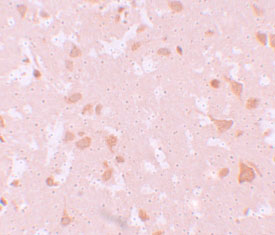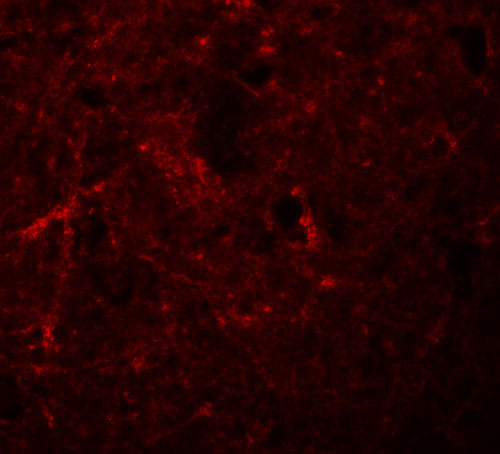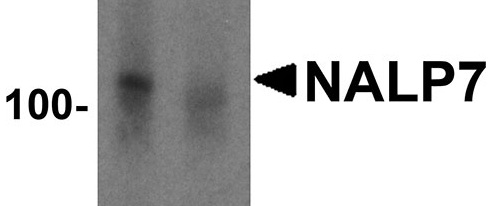NALP7 Antibody
- SPECIFICATION
- CITATIONS
- PROTOCOLS
- BACKGROUND

Application
| WB, IHC-P, IF, E |
|---|---|
| Primary Accession | Q8WX94 |
| Other Accession | NP_631915, 46049100 |
| Reactivity | Human |
| Host | Rabbit |
| Clonality | Polyclonal |
| Isotype | IgG |
| Calculated MW | 111807 Da |
| Application Notes | NALP7 antibody can be used for detection of NALP7 by Western blot at 1 µg/mL. Antibody can also be used for immunohistochemistry starting at 10 µg/mL. For immunofluorescence start at 20 µg/mL. |
| Gene ID | 199713 |
|---|---|
| Target/Specificity | NLRP7; |
| Reconstitution & Storage | NALP7 antibody can be stored at 4℃ for three months and -20℃, stable for up to one year. As with all antibodies care should be taken to avoid repeated freeze thaw cycles. Antibodies should not be exposed to prolonged high temperatures. |
| Precautions | NALP7 Antibody is for research use only and not for use in diagnostic or therapeutic procedures. |
| Name | NLRP7 |
|---|---|
| Synonyms | NALP7, NOD12, PYPAF3 |
| Function | Inhibits CASP1/caspase-1-dependent IL1B secretion. |
| Tissue Location | Expressed in numerous tissues including uterus and ovary, with low levels in heart and brain. Not detected in skeletal muscle. |

Thousands of laboratories across the world have published research that depended on the performance of antibodies from Abcepta to advance their research. Check out links to articles that cite our products in major peer-reviewed journals, organized by research category.
info@abcepta.com, and receive a free "I Love Antibodies" mug.
Provided below are standard protocols that you may find useful for product applications.
Background
NALP7 Antibody: NOD proteins include the apoptosis regulator APAF1 (apoptotic protease activating factor 1) and mammalian NOD-LRR proteins. NALP7, also known as PYPAF3, a member of the related PYRIN-containing APAF1-like proteins (PYPAFs/NALPs) is thought to play a crucial role in cell proliferation. NALP7 has a C-terminal leucine-rich repeat (LRR) region, an N-terminal Pyrin domain (PYD) followed by a NACHT domain, and a NACHT-associated domain. It is expressed in numerous tissues including uterus and ovary, with low levels in heart and brain. NALP7 inhibits caspase-1-dependent interleukin-1β secretion and is a feedback regulator of interleukin-1β secretion. Defects in the NALP7 gene are known to cause the formation of a hydatidiform mole (HYDM) and reduce the growth of carcinoma cell lines.
References
Tschopp J, Martinon F, and Burns K. NALPs: a novel protein family involved in inflammation. Nat. Rev. Mol. Cell Biol.2003; 4:95-104.
Kinoshita T, Wang Y, Hasegawa M, et al. PYPAF3, a PYRIN-containing APAF-1-like protein, is a feedback regulator of caspase-1-dependent interleukin-1beta secretion. J. Biol. Chem.2005; 280:21720-5.
Okada K, Hirota E, Mizutani Y, et al. Oncogenic role of NALP7 in testicular seminomas. Cancer Sci.2004; 95: 949-54.
Murdoch S, Djuric U, Mazhar B, et al. Mutations in NALP7 cause recurrent hydatidiform moles and reproductive wastage in humans. Nat. Genet.2006; 38: 300-2.
If you have used an Abcepta product and would like to share how it has performed, please click on the "Submit Review" button and provide the requested information. Our staff will examine and post your review and contact you if needed.
If you have any additional inquiries please email technical services at tech@abcepta.com.













 Foundational characteristics of cancer include proliferation, angiogenesis, migration, evasion of apoptosis, and cellular immortality. Find key markers for these cellular processes and antibodies to detect them.
Foundational characteristics of cancer include proliferation, angiogenesis, migration, evasion of apoptosis, and cellular immortality. Find key markers for these cellular processes and antibodies to detect them. The SUMOplot™ Analysis Program predicts and scores sumoylation sites in your protein. SUMOylation is a post-translational modification involved in various cellular processes, such as nuclear-cytosolic transport, transcriptional regulation, apoptosis, protein stability, response to stress, and progression through the cell cycle.
The SUMOplot™ Analysis Program predicts and scores sumoylation sites in your protein. SUMOylation is a post-translational modification involved in various cellular processes, such as nuclear-cytosolic transport, transcriptional regulation, apoptosis, protein stability, response to stress, and progression through the cell cycle. The Autophagy Receptor Motif Plotter predicts and scores autophagy receptor binding sites in your protein. Identifying proteins connected to this pathway is critical to understanding the role of autophagy in physiological as well as pathological processes such as development, differentiation, neurodegenerative diseases, stress, infection, and cancer.
The Autophagy Receptor Motif Plotter predicts and scores autophagy receptor binding sites in your protein. Identifying proteins connected to this pathway is critical to understanding the role of autophagy in physiological as well as pathological processes such as development, differentiation, neurodegenerative diseases, stress, infection, and cancer.




